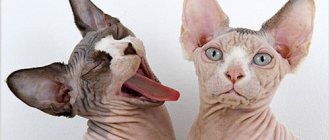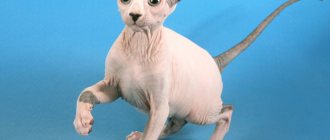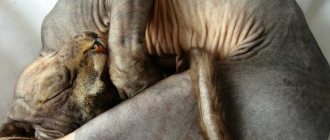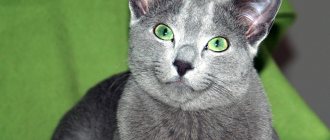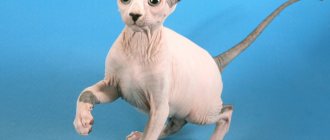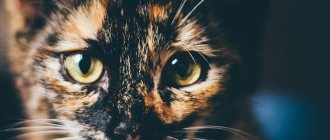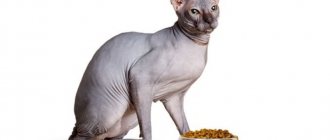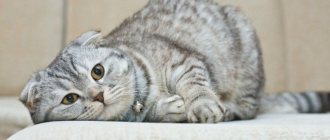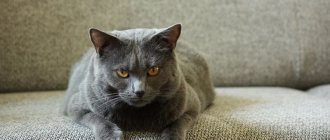Sphynxes are unusual cats that resemble aliens from another planet. Due to a genetic mutation and careful selection work, their body is completely or partially hairless. Because of this, representatives of the breed have a higher body temperature and require special conditions of detention.
Let's figure out how to care for the Sphynx in order to provide it with a comfortable and fulfilling life.
The main principles of proper feeding
To feed Sphinxes, you can use both dry and wet food. But regardless of the type chosen, you must remember the following rules:
- The cat should receive a strictly dosed portion. This breed is prone to overeating.
- When choosing a diet, age must be taken into account. Kittens, adult pets, pregnant females and older cats have their own feeding habits.
- Compliance with the regime. The Sphinx must receive food at the same time. In this case, you don’t have to worry about the digestion process, since these cats often suffer from stomach pain.
Thanks to their accelerated metabolism, Sphinxes have an excellent appetite and sometimes eat completely non-cat foods.
Holistic dry food
Industrial feed
The requirements for feeding pets with prepared food - dry or wet - are standard. This:
- Strict adherence to the daily norm. Manufacturers always indicate the serving size on the packaging.
- When choosing food, you need to take into account the age of the Sphinx. For kittens, adult pets, pregnant, spayed/sterilized and elderly cats, we offer our own food that takes into account their age needs.
- Free access to clean water when dry feeding. If the cat drinks little, then forced supplementation or transfer to another type of food is necessary.
It is strictly forbidden for Sphynx cats to be given food below the premium level. In cheap formulations, the source of protein is soy, wheat and corn, but plant proteins are practically not absorbed by the cat’s body. The share of meat components is minimal and of poor quality. As a rule, fat, feathers and offal are used in production.
Natural products
When choosing the option of feeding “natural”, you need to ensure that the nutrition is completely balanced. The cat's menu should include the following products:
- beef and veal;
- chicken offal – neck, heart, gizzards, liver;
- seafood, turkey, chicken - raw;
- steamed fish (cod, salmon);
- boiled egg yolk;
- fermented milk products – cottage cheese, yogurt and others;
- cereals;
- cereals – buckwheat, rice;
- vegetables fruits.
Advice! You need to remove all the bones from the fish and grind the meat in a meat grinder.
Recommendations for creating a menu for the week:
- well-frozen and scalded raw beef/veal – daily;
- boiled chicken – up to 4 times;
- boiled/frozen offal - no more than three times;
- porridge (from rice, buckwheat, oatmeal and wheat) - up to three times;
- vegetables, fruits (fresh, boiled) - up to three times;
- sour milk, cheeses – 1 time;
- heat-treated sea fish fillet, egg yolk.
It is recommended to season ready-made dishes with a small amount of vegetable oil, but adding salt or sweetening food is prohibited. In addition, food should be at room temperature.
Vitamin and mineral supplements
If industrially produced food is used to feed the Sphinx, then no additives need to be introduced.
When feeding “natural” food, you must add:
- brewer's yeast - they are suppliers of B vitamins;
- ready-made mineral supplements, for example, Kizim.
The dosage of yeast should be calculated by a veterinarian based on the weight of the cat.
Graceful kitty
Sample menu by age
For kittens, it is necessary to create an approximate menu by age, since the needs of a growing body change every month. During this time, you need to decide on the type of diet and start appropriate complementary feeding.
Up to a month
In the first month of life, the kitten must feed on mother's milk, with which it receives antibodies to form strong immunity. It also helps to balance the colonization of the intestines with microflora.
If natural nutrition is not possible, then the baby is fed artificially. For this, an industrial substitute, diluted goat's milk or infant formula is used.
Feeding regimen for kittens up to a month:
- the first 14 days - every 2 hours (10-12 times a day);
- from 15 to 30 days - every 2-3 hours with a break for sleep (8-9 times a day).
During the first month, it is better for the owner to focus on the kitten’s wishes. If he asks for food, then you need to feed him. The daily portion is from 40 to 60 ml. It depends on the size and health status of the baby.
1 month
At 1 month it is allowed to introduce the first complementary foods, which depends on the chosen diet. Products for natural menu:
- cat milk;
- goat milk diluted with warm water;
- lean meat broth;
- boiled minced meat with a homogeneous structure.
If the owner has chosen a commercial diet, then feeding continues with a cat's milk replacer or infant formula. If there is growth retardation, the kitten is given pate or mousse.
The daily portion depends on the rate of growth and development. The amount of food ranges from 45–50 g to 80–90 g. Feeding regimen is 6–7 meals, excluding liquid food (milk).
2 months
At 2 months, kittens begin to grow stronger and grow faster. Nutrition Features:
- With a natural menu, liquid food (milk, broth) and minced meat remain. New products are being included: fermented milk products, chopped raw beef after preliminary freezing.
- Commercial diets retain cat milk replacer or infant formula. Special canned food for kittens is introduced on an ongoing basis.
The daily portion increases to 65–100 g. The number of meals is reduced to 5–6 times, excluding milk or industrial substitute. At this age, vaccination begins, so a slight weight loss may be observed, which is considered normal.
3 months
When they reach three months of age, kittens begin to be separated into new families. This is accompanied by stress for the pet, so it is necessary to ensure a comfortable transition. It is advisable for the owner to find out what the breeders fed the baby. Innovations in diets:
- The natural menu becomes more varied and nutritious. It is allowed to introduce cottage cheese, quail eggs, raw meat in pieces, grated vegetables (carrots) or apples.
- The commercial diet is supplemented with semi-moist kitten food (pieces in jelly or gravy).
Hairless Canadian or Don kitten at 2 months
Sphynx kittens are adopted at approximately 2 months of age. Until this time, they are breastfed and receive their first complementary foods.
The owner needs to decide on the type of feeding - choose natural or wet food or dry food. If preference is given to the latter option, then special premium and higher class food is purchased, intended specifically for kittens. Before giving, the granules must be softened in advance with water.
Many premium manufacturers offer wet food. The feeding rate is indicated on the packaging.
But for the first days after the move, the kitten continues to be fed what it received at the breeder’s house. A change of place of residence and the absence of a mother is extremely stressful for a pet, and a change in its usual diet will only increase it. New nutrition is introduced gradually. The intestines will be completely rebuilt within a week, and will absorb food that is unusual for it in full.
If the new owner does not know what the kitten was fed by the breeder, then you can follow the standard recommendations. The menu should include:
- ground veal – boiled or well frozen and scalded;
- cottage cheese;
- egg yolk;
- a mixture of meat and vegetables in the form of a pate.
At 2 months of age, a kitten should eat up to 6-8 times a day, in small portions. Therefore, you will have to feed him at night, if necessary. This regimen must be maintained until 4 months of age.
Ragdoll cat breed, description of colors and photos, as well as their character, standards and sizes
The average volume of one serving for a 2-month-old Sphinx is 25 g. It can be increased or decreased. The owner makes adjustments independently, focusing on the physical condition and activity of the kitten.
At the age of 2 - 3 months, calcined cottage cheese, vegetables, spinach, unsalted cheese and sour milk are gradually added to the menu.
Advice! It is advisable to give fermented milk as an independent dish, for example, during an afternoon snack.
And the Canadian Sphynx, and the Don, and the Dwelf, and the Cohons, and the Minskin, and the Bambino, and the Ukrainian Levkoy, and the Elf have a sensitive stomach, so all uneaten food should be thrown away immediately so that it does not become a source for the growth of bacteria and the cause of food poisoning.
Clean water, which must be renewed at least once a day, should always be freely available. Otherwise, the kitten may experience constipation and develop dehydration.
Training and education
The affectionate and sociable nature of Sphynx cats, combined with high intelligence and good memory, make them ideal pets suitable for home keeping. A well-mannered cat will not damage furniture, ride on curtains or do other dirty tricks. Therefore, it is extremely important to have time to form the correct model of behavior in the kitten in the house.
On a note. You need to raise a Sphinx without using physical force. To stop unwanted actions or calm down an overly naughty kitten, you can lightly shout at it, splash water, or hiss threateningly.
Raising a Sphinx includes training in hygiene procedures. The kitten is taught to be calm about bathing, trimming nails, rubbing eyes, cleaning ears and teeth.
Toilet training
Even if the breeder’s kitten regularly went to the litter box, this does not mean that in the new home he will not recover anywhere. Therefore, to prevent the apartment from turning into a latrine for a cat, from the first moment the pet appears, you need to pay attention to its toilet training.
Typically, kittens defecate after sleeping or eating. Noticing that the baby is about to go to the toilet, he is carefully picked up under the stomach and taken to the tray. As soon as he does his job, he will definitely be praised.
On a note. If the kitten went to the toilet in the wrong place, the puddle is blotted with a napkin, which is then placed in the tray. And the “crime scene” itself is wiped with water flavored with a small amount of citrus juice.
Elderly cats
Older Sphinxes play little and prefer to sleep most of the day. And if you don’t limit your daily caloric intake, your cat will begin to actively gain weight. For this reason, the volume of the usual portion is reduced by about 1/3, but this must be done gradually.
The cat's meals should be frequent and in small portions. The menu remains the same.
Elderly Sphynx cats need the following supplements to strengthen their immune defenses:
- vitamin C;
- fish oil – it contains Omega-3 fatty acids;
- vitamins of group A, B, E.
If a cat receives dry or commercial wet food, then it does not need to receive supplements.
Dry food - complete food
Vitamins and supplements
Vitamins and supplements are an important part of a proper cat diet. They help replenish nutrients, which keeps your pet healthy. Types and examples of additives:
- natural sources - beef or chicken liver, vegetable oils, yeast, herbs or grass, vegetables;
- pharmaceutical preparations - vitamin complexes, products with Omega-3, fish oil, feed additives.
Among pharmacy vitamins, the manufacturer Polidex is distinguished. The company produces 4 types of complexes:
- Super Wool – for leather and wool;
- Gelabon plus Glucozamine – to strengthen the bones;
- Immunity Up – for immunity;
- Multivitum.
An important amino acid for kittens is taurine. It is usually included in ready-made feeds. Natural products with taurine: offal, turkey, sea fish, homemade yogurt.
Examples of recommended industrial feeds
Industrially produced food includes components necessary for the full development of a cat. They guarantee a balanced diet, which is what attracts Sphinx owners. Manufacturers offer both dry and wet food.
Dry granulated
The following varieties can be used to feed hairless cats:
- Royal Canin. Designed for pets of all age groups. The manufacturer offers different flavors, as well as specialized foods, for example, for kittens and pregnant/lactating females.
- Hill's Science Plan Adult Lamb. The granules contain the proteins, Omega-3 fatty acids, antioxidants and other components necessary for the cat to strengthen the immune defense, as well as maintain a stable weight.
- Purina Pro Plan Delicate. For its production, only high quality natural products are used.
- Orijen Cat & Kitten. Designed for feeding kittens and adult cats. Contains only natural ingredients. The line offers meat and fish food.
- ACANA Grasslands for Cats. Hypoallergenic, easy to digest, made from natural products. It has a completely balanced composition.
When purchasing, you must track the production date and permissible storage duration.
Wet bagged or canned
To feed Sphinxes, it is recommended to choose the following manufacturers of wet food:
- Leonardo. It has a completely natural composition with a high meat content. Contains complexes of vitamins and minerals.
- Applaws. Made from quality products. The line offers food in different flavors.
- 1st Choice. Hypoallergenic, fully balanced composition. Contains probiotics to improve digestion.
- Almo Nature. Made from high-quality meat or fish, and also includes the necessary components for cat health.
- Grandorf. The food is made from high-quality dietary meat. Hypoallergenic, fully balanced.
The Sphinx has an excellent appetite
Sphinx - features of the breed
Having studied the characteristics of the breed, you can create an optimal, personalized diet for the kitten. Proper nutrition, which is monitored and adjusted, is the key to a pet’s health.
It is important to understand that even if a cat has predispositions or chronic diseases, quality care and a balanced diet can significantly improve their standard of living.
A balanced diet for the Sphynx is prevention:
- Acne (acne disease).
- Dermatitis.
- Diseases of the teeth and oral cavity.
Sphynx cats spend a lot of energy heating their own bodies, so they eat a lot and are rarely overweight.
However, feeding a cat with a hormonal imbalance leads to frighteningly rapid weight gain, which can lead to the development of heart failure.
Many potential owners, trying to save the family budget, buy kittens with unconfirmed breed value. In most cases, such kittens turn out to be mixed breeds over several generations.
Unfortunately, it was precisely thanks to the desire to save money that the myth spread that all Sphynx cats suffer from allergies and acne. Yes, such pathologies can worry a purebred cat, but in mestizos, they manifest themselves with almost 100% probability.
Don and Canadian sphinxes - differences and features
Many people know that there are hairless cats and do not see any differences in them. Today, hairless cats include:
- The Don Sphynx is naked and velor.
- Canadian Sphynx – hairless and brushed.
- The Peterbald or St. Petersburg Sphynx is a young, hairless cat breed bred in Russia.
- Ukrainian Levkoy is a very rare hairless breed of cat with round ears.
- Bambino is a very rare miniature hairless cat breed.
There are also cats with partial fur: Devon Rex, Cornish Rex and Lykoi. The Canadian and Don Sphynx have the absolute leadership in population size, popularity and prevalence.
How are they different?
- Canadian Sphynxes have been bred for more than half a century, the Don variety is much younger.
- Canadian Sphynxes have rounded muzzle features, while Don cats have a sharp muzzle with clear lines.
- Canadian Sphynxes do not have mustaches; Don Sphynxes most often have mustaches.
- All Don Sphynxes have light fluff; among Canadians there are completely hairless individuals.
- Canadian Sphynxes are graceful, while Don Sphynxes have an athletic build.
- The Canadian Sphynxes have folds, the Don Sphynxes have almost none.
The main difference between breeds is health! Canadian Sphynxes are inferior in this regard to their brothers due to the age of the breed. Many Canadian owners are forced to keep their pets on hypoallergenic or preventive food in old age.
Important! When purchasing a kitten from a nursery, after a veterinary examination, from healthy breeders, the risks are minimal.
What is prohibited and why you can’t eat from the table
Sphynx cats are not picky about food and eat almost everything they can get their hands on with great pleasure. But due to a weak stomach, their diet must be strictly controlled and not spoil the cat with food from your table.
Pets of this breed are prohibited from adding additives such as salt, preservatives, spices and sugar. For this reason, they should absolutely not be given sausages, sausages, canned meat and fish, or fried foods.
Main list of prohibited products:
- cutlets;
- pork in any form;
- chicken bones;
- smoked meats;
- sweets and baked goods;
- meat stew;
- canned fish;
- fresh whole milk, as Sphynx cats often suffer from lactase intolerance.
Eating “human” food causes severe diarrhea in these cats, causes other digestive disorders and provokes dysbiosis.
Leather and fur of the Canadian Sphynx
The Sphinx looks completely naked, but in fact it is not. The animal's skin is covered with fluff - tiny short hairs. More pronounced fur covers the bridge of the nose, ears, paws, scrotum and tail of the animal - there may even be a funny tassel on the tail.
"Suede" cat
Thanks to this feature, Sphynx cats are very pleasant to pet. The hand slides over the hot body, like over soft suede. The Canadian feels like a peach. There are no absolutely naked (“rubber”) Sphynxes. The skin has hair follicles, and the coat of these cats is described as "visibly hairless". Short, curled eyebrows and mustaches may grow, although many Sphynx cats lack them altogether.
Tricolor Sphynx cat
Kittens are born folded and hairless. With age, the folds smooth out. Some adult animals retain charming wrinkles, but recently the course has been taken towards the “smooth” Sphynx. The folds should be on the head, neck, and paws. The skin of hairless cats is thick (difficult to pierce with a needle!) and elastic.
A Sphynx kitten cannot be confused with any other breed.
Any color is acceptable for the breed, although due to the lack of fur, color can be difficult to determine. The skin can be colored red, black, gray or colorless - pale pink. Like people, sphinxes tan in the sun - in summer their skin darkens in light areas.
Sphynxes love to bask in the sun
The hairless gene is recessive. It only appears if it was received from both parents. If a Sphynx breeds from an ordinary fluffy cat, there will be no hairless kittens in the litter.
Is it possible to only wet food or only canned food?
The choice of type of cat food depends on the wishes and capabilities of the owners, so the pet can be fed either only wet food or only canned food.
Description of the Bengal cat breed, its character, behavior and color features
The only requirement is that you must choose products of at least premium class. In this case, both canned food and wet food contain all the substances necessary for the proper development of the pet.
Is it possible to have different types at the same time?
When choosing food for a cat of this breed, you need to give preference to one type of food: either dry, wet, or natural. It is extremely undesirable to practice feeding two different species at the same time, since the Sphinx’s digestive system is not adapted to rapid adjustment.
Warning! If, nevertheless, the decision on a mixed diet is made, then “drying” is offered in the morning, and natural food in the evening. The order can be changed.
Also, you cannot mix “drying” from different manufacturers. Each manufacturer uses their own proportions and ingredients, and also gives specific recommendations on standards. When mixing granules of different compositions, there is no question of a balanced diet.
Stainless steel bowl
Water
The average daily water consumption is 45–55 ml per 1 kg of body weight. It changes depending on the diet. When feeding dry pads, the quantity will need to be increased, since the pellets contain almost no moisture. On a natural diet, the need is lower, since liquid comes from foods.
The main rule is that the water must be clean, fresh, free of foreign tastes and odors. The contents of the drinking bowl are changed every day. If food residue gets in, you will need to change it more often. Drinking bowls are placed next to the bowl or in another place with free access.
Choosing a bowl
The bowl should be comfortable, safe and practical. Ceramics fully meets these requirements. Such bowls are easy to clean and do not slide on the floor when the cat eats.
But ceramics is a rather fragile material. An alternative option is stainless steel cookware. But since metal bowls can slide on the floor, they need to be placed on a special stand.
Better yet, purchase an automatic cat feeder. In this case, you will always be sure that your pet is not only fed correctly, but also on time, even in your absence.
It wouldn’t hurt to add a special automatic waterer to the kit so that the cat is constantly provided with fresh water, filtered from contaminants.
Expert advice
In order for your pet to grow up healthy, playful and remain so until old age, you must follow the recommendations of professional breeders. Here they are:
- The cat must eat. Otherwise, due to lack of energy, it will freeze even in a very warm room.
- One drop of vitamin D should be added to the food every day. It is necessary to strengthen bones, as well as maintain normal functioning of the nervous system.
- To remove tartar, sphinxes need not only to brush their teeth, but also to give boiled chicken necks once a month.
- If constipation occurs, fermented milk products are introduced into the pet's menu. To prevent the appearance of hard stools, a little vegetable oil - flaxseed or olive - is added to food.
- Fish is allowed, but not often. It contains a large amount of protein, which can cause the development of urolithiasis. River fish is completely prohibited.
- Seafood can be offered no more than twice a week, having previously selected all the bones from it.
- Both Don Sphynxes and Canadian Sphynxes should not be given whole milk, since the cats’ intestines do not digest lactose.
- It is highly undesirable to practice a mixed diet. To digest dry food granules and natural food, the stomach produces digestive juices of different composition. The food simply will not have time to be digested, and the cat will begin to have problems with stool.
Origin of the Canadian Sphynx
Abroad, these cats are simply called “Sphynx”. The prefix “Canadian” is used only in Russia.
The hairlessness mutation (the gene was named hr) was identified in Canada in 1966. In Ontario, an ordinary mongrel cat gave birth to a hairless kitten, wrinkled like a dried plum. It was called Prune (Prune) - Prune.
After Prune mated with his mother, hairless kittens were born in the litter. To consolidate the mutation, he was repeatedly bred with hairless cats. But the experiment failed - due to inbreeding, the kittens died and were sick. In 1971, the breeding of hairless cats was suspended.
Another hairless kitten was born on the border with Canada, in Minnesota in 1975, from an ordinary short-haired cat. It was called Epidermis. Epidermis' mother will give birth to another hairless kitten a year later, this time a girl. Epidermis is purchased by a hobby breeder from San Francisco, David Mare. To pair with him, he buys a hairless cat from Holland named Alopecia Totalis. David also had a third hairless cat from North Carolina, which was successfully exhibited at shows. But no information has been preserved about the descendants of David Mair's cats.
Canadian Sphynx
In 1978, in Toronto, Canada, Siamese cat breeder Shirley Smith picked up a cat with 2 kittens on the street, one of which was naked. The black and white hairless cat was named Bambi, he was neutered and lived for 16 years (until 1994).
In 1980, Bambi's mother brings a new litter, containing two hairless cats. These animals are probably undocumented descendants of Prune. They travel to Holland, where they are given the names Punkie and Paloma.
It was the cat Punkie who was bred with a Devon Rex cat. The result of the mating was hairless kittens in the first generation.
But let's return to America. Hairless kittens begin to be born on a Minnesota farm in 1975. In 1981, the Persons sold two adult hairless cats to Stardust Cattery in Oregon to breeder Kim Muesk. They were called Epidermis and Dermis. This has created some confusion, with a cat named Epidermis being confused with David Mair's Epidermis the cat.
Hairless cats were called “lunar” until the original and mysterious name “Sphinx” was invented
Kim mated hairless cats with different cats, but all the kittens were covered with fur. Then, on the advice of another felinologist, she acquired a Devon Rex. So Sphynxes were bred using this breed both in Holland and in the USA.
In 1985, a Sphynx nursery appeared in Texas, and interest in them grew. Hairless cats continue to be crossed with Devon Rex and American Shorthair cats, increasing the gene pool of the population. Nurseries actively exchange kittens.
The international organization for the breeding and development of new breeds of cats (Cat Fanciers' Association, CFA) recognized Sphynxes only in 1998. In 2002, the breed standard for judging was approved.
Canadian Sphynx on a walk
Until 2010, matings of Canadian Sphynxes with Devon Rexes were allowed. Now the breed is closed for interbreed matings. A Canadian Sphynx is considered purebred if its ancestors were Sphynxes in 4 generations.
